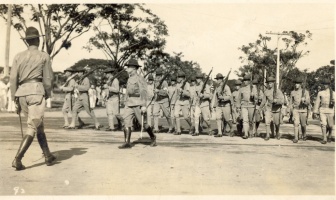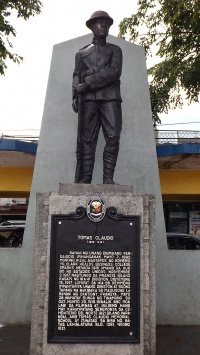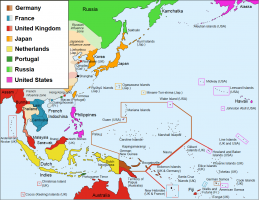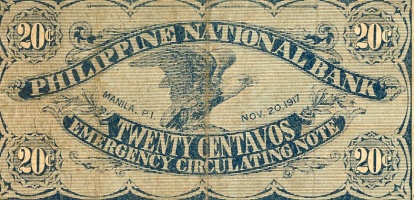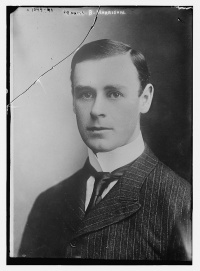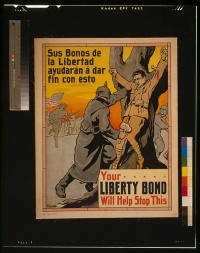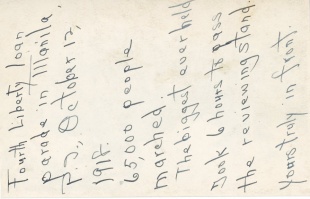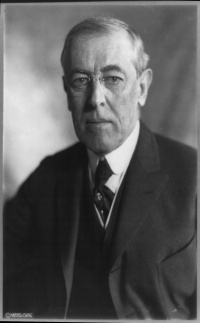Introduction↑
Philippine participation in World War I was relatively minor compared with other Asian countries. But Filipinos were keenly aware of the war and wanted to participate. The Philippine National Guard (PNG) was formed and offered, but the United States did not act until it was too late. Other Filipinos, working in the United States, enlisted in the US armed forces and saw action. This paper seeks to present an overview of the Philippine experience in World War I - why Filipinos tried to get involved, and how and in what manner they did get to contribute.
1914-1916: Geographically Distant, but Keenly Felt↑
When the Great War broke out in Europe in 1914, the Philippines had been a colony of the United States for fifteen years. Filipinos had fought a bloody war against the Americans from 1899 to 1901, continuing in other parts of the country until 1913. The second decade of the 20th century brought a more liberal colonial policy under President Woodrow Wilson (1856-1924). President Wilson’s appointment of Francis B. Harrison (1873-1957) as governor-general further strengthened the belief that Philippine independence would come soon, as Harrison was supportive of the Filipino cause.
Self-government and the potential passage of a law promising independence for the Philippines occupied the thoughts of most Filipinos, and the Great War was not given serious thought.[1] The United States took a neutral stance and attempted to stay out of the conflict, and the Filipinos saw no need to join the war in Europe. As Europe plunged into full-scale war in August 1914, President Woodrow Wilson issued a series of proclamations announcing American neutrality. These proclamations were immediately published in the Philippines.[2]
Harrison implemented measures to ensure that consulates of the warring nations would not bring the conflict to Philippine shores, and would respect its neutrality. This meant preventing propaganda and espionage on Philippine soil, and protecting the international rules on freedom of navigation. Import or export of contraband from the archipelago were banned. Warships of nations at war were not allowed in Philippine waters for more than seventy-two hours.[3]
But while the United States and the Philippines attempted to stay away from the war, the war’s impact was felt. The immediate effect was on shipping. German merchant ships had routinely traded with the Philippines and a number sought safety in Philippine ports, lest they be attacked by British warships. A month after the outbreak of war, twenty-three German ships were anchored in Philippine waters. Trade between the Philippines and Germany and Austria-Hungary ceased. British and other ships were rerouted to Europe for use in the war. These ships played a significant part in the commerce of the Philippines and their loss hit the Philippine economy hard. Exports dropped and as a result, revenues fell; vital imports could not enter in sufficient quantity. Prices of basic commodities thus rose, and the government took appropriate steps.[4]
The Philippine Insular Government closely watched the German and British consulates in Manila to prevent spying and the spread of propaganda that might seek to weaken the US position in the Philippines. Governor-General Harrison had to warn the respective consuls to refrain from such activities.[5]
On 29 August 1916 the Philippine Autonomy Act was signed into law. The law promised that the United States would recognize Philippine independence once Filipinos proved capable of self-government. This brought great jubilation to the Philippines, and elections held in October 1916 created an all-Filipino bicameral legislature. Governor-General Harrison remained as chief executive, but the previous hold by Americans of the national legislative process was ended. Manuel L. Quezon (1878-1944), who had fought the Americans in 1898-1899, was elected president of the Philippine senate. When the war started, he had been Philippine resident commissioner in Washington, where he kept abreast of American developments and had befriended many American legislators.[6]
Filipinos were appointed to positions of political power by Governor-General Harrison. Quezon and others entertained thoughts of creating a Philippine army (up to this time the only armed forces were directly under the control of the United States), with compulsory military service.[7]
With the promise of independence, Filipino outward loyalty to the United States also grew stronger. Should the USA join the war, Filipinos would show their gratefulness and loyalty by joining the war on the side of the United States.[8] The experience of the Philippines at this point was quite different from that of the other colonized peoples in Southeast Asia. With independence seemingly within reach, the Philippines could prove their readiness by actively participating in the Great War.
US Entry into the War↑
In February 1917, Germany announced the resumption of unrestricted submarine warfare. President Wilson responded by breaking diplomatic relations with Germany. Despite strong rhetoric against Germany, a declaration of war did not follow immediately.
The breaking of US relations with Germany meant that the German ships in Philippine waters, which had been interned since 1914, would be seized. Rumors spread that the German crews were preparing to sabotage the ships, and the insular government took over the ships before any serious damage was done. The seizure provided for immediate relief to the shortage of ships for Philippine commercial and passenger traffic.[9]
Earlier, in January 1917, Wilson addressed the US Congress and stated that the United States sought to make the world “safe for every peace loving nation.” In a subsequent speech on 2 April 1917, he announced that the US would fight “for the rights of nations, great and small” emphasizing democracy and the protection of small nations. [10] Quezon noted that Wilson’s pronouncements “struck a responsive chord in the hearts of the Filipino people.” Quezon received messages from Filipinos from all over supportive of the US and expressing willingness to fight alongside the US.[11]
The US Congress declared war against Germany on 6 April 1917. Even before the US declared war, Quezon went to the US to inform Wilson of the Filipinos’ sentiments. With Filipinos totally behind the US, American military forces could be removed from the Philippines to fight in Europe - and leave Philippine security in Filipino hands. This situation was a testament to the success of American colonial policy, he stressed. The only all-American garrison unit in the Philippines, the 31st Infantry Regiment, was in fact dispatched to participate in the Siberian Intervention, and the remaining troops under US command were Filipino.[12]
Filipino political leaders vowed to cooperate. Agitation for independence, which had characterized the years of American rule, was suspended, and a planned mission to Washington to hasten Philippine independence was postponed. Quezon and his co-legislators felt it more meaningful to affirm loyalty to the United States, and adherence to liberty and democracy. Filipino members of the cabinet presented a resolution to Harrison to that effect. Harrison in turn wrote Wilson, offering a whole infantry division to the United States, to fight in Europe under General John J. Pershing (1860-1948). General Pershing had led the American campaign to subdue Filipino Muslims in Mindanao, and was well remembered. Now that he was appointed commander of the American Expeditionary Force to Europe, Filipinos would feel honored to fight with him.[13]
When the new Philippine legislature convened its first session in October 1917, it immediately passed a joint resolution expressing total and unequivocal loyalty to the United States. The US ideals were precisely the same as those of the Filipinos. Highlighting Filipino sympathy to the American cause, 24 October 1917 was declared a public holiday known as Liberty Day.[14]
The Philippine National Guard↑
Morale was high given the passage of the Philippine Autonomy Act, and the promise of Philippine independence. The war would be an opportunity to place the Philippines on the world map and be recognized, among other things. Prior to the formal US declaration of war, Harrison and Quezon had introduced a bill that would authorize the creation of a Philippine militia, with active duty elements becoming the Philippine National Guard. This armed force could be sent to Europe to fight in the war, and afterwards would become the basis of the Philippine army. It could also protect the peace in the Philippines, thus freeing American servicemen to fight overseas.[15] The creation of the national guard would strengthen the Philippine cause for independence, being ready to defend itself.
Support was widespread from top down. Harrison, expecting to be appointed commander of the force, appeared in uniform, as did Quezon. Thousands of Filipinos marched to the governor-general’s official residence to voice their willingness to join.[16]
Arms, ammunition and guidance would necessarily have to come from the US army, and funds for the division would have to be legislated in Washington. Despite the Filipinos’ ardor, neither the US Congress nor the War Department addressed the request, caught up with the enormity of mobilizing US forces to dispatch to Europe.[17]
Despite the lack of any positive response from the United States, Harrison and Quezon pushed through and called on Filipinos to enlist. A delegation, led by Quezon, was sent to Washington to reiterate the earnestness of the Filipino offer and urge action. Quezon noted that Wilson received the news “with unconcealed enthusiasm.”[18]
Harrison declared the Militia Act in full force in June 1917 and enlistment centers were opened. The PNG’s first organized units - some 600 strong - paraded in Manila a month later, on 4 July 1917. An officers’ training school was opened and an aerial unit organized.[19]
But the US War Department was not enthusiastic about the Philippines’ offer, partly on discriminatory grounds: several senior American officers held Filipinos in contempt, doubting their abilities. There were also practical issues: with large numbers of American volunteers going to Europe, there were little arms to provide Filipinos. A creeping fear was that if Filipinos were provided arms, they might rebel against the Americans. Furthermore, it was unthinkable to send an untrained and un-acclimated Filipino unit to France. To send the division to the United States to free more American officers and men to go to Europe, particularly on the Mexican border, would only expose them to discrimination as colored people.[20]
The US Congress finally passed a bill in January 1918, authorizing the US president to call the Philippine National Guard to federal service. Wilson quickly signed it into law, authorizing US government support for a 14,000-man division for only one month.[21]
Training and enlistment continued with very limited resources. A new camp was opened specifically for the National Guard south of Manila. The aero squadron received its first planes, and Filipinos learned to fly military aircraft for the first time. But there was no actual call to federal service.[22]
After a long delay, the formal call to US federal service was issued in September 1918. Troops assembled at the newly cleared camp which was named after the first Filipino to die in World War I, Tomas Claudio (1892-1918). Many more Filipinos volunteered: the faculty and student body of the University of the Philippines’ College of Agriculture volunteered almost to a man. The acceptance ceremony was scheduled for 14 November 1918.[23]
Before the PNG could be federalized, World War I had ended. Ironically, the PNG was officially considered fully mobilized on 11 November 1918. The federalization ceremony and parade went on as scheduled on 14 November 1918, but the parade turned pathetic, since the men were equipped with aging ill-fitting uniforms and equipment that made the parade the brunt of jokes. More than 180 men died from disease or other causes, without leaving the Philippines.[24]
The PNG - 14,235 officers and soldiers - was officially accepted only on 20 November 1918. Per US legislation, only one month of training was borne by the US government. The Philippine legislature added another two months’ pay, extending the PNG’s life until 19 February 1919. After that date, the PNG was demobilized. The Philippine Air Service, the aerial component of the PNG, continued as a separate organization for two more years, but it too was disbanded.[25] Despite its short life, the PNG was the first time a Filipino military organization was organized while under American rule.
Filipinos in the US Armed Services and Their Participation in the War↑
While the Philippine National Guard did not see action, scores of Filipinos did enlist in the US armed forces. Many saw action on the front lines in France as members of the US Army; thousands served on ships manned operated by the US Navy and the British merchant marine. Details of their service are sketchy, except for the first Filipino to die against the Germans in France, Private Tomas Claudio. Claudio was born in the province of Rizal, close to Manila, in 1892. He reportedly had a liking for military service as a boy, and excelled in military drill in primary school. He went to the United States to work, in order to support his widowed mother and two siblings. When the United States declared war, he tried to enlist in the US Army, but was rejected apparently because he was not tall enough. He was finally accepted in November 1917. As he began to train with American troops, Claudio wrote his sister: “If fortune is against me, you will have the consolation of knowing that you had a brother who knew how to fulfill his duty to his country.”[26]
Claudio was assigned to the 41st Infantry Division, which sailed to France in December 1917. He was then transferred to the 1st Infantry Division, which needed replacements after several costly battles. Private Claudio saw action in various battles, and in May 1918, charged at Cantigny from the front-line trenches. This resulted in a major victory for the Americans in France.
In June 1918, Claudio was in the trenches in Oise, northern France. He went over the top on 28 June 1918, fought hand to hand with German soldiers and was bayonetted several times. He was evacuated to Field Hospital 12 in the rear, but died of his wounds. He was buried in a US military cemetery.
Tomas Claudio’s death was given prominence in the Philippines, and he was honored as the first Filipino to die for the cause of democracy and freedom in a foreign land. The main camp of the Philippine National Guard was named after him.[27]
Another Filipino who fought and died in France was Pvt. Andres P. Dadizon (?-1918), from the southern Philippine island of Biliran. He had gone to the United States to work and had enlisted in the US Army to fight in France. He fought on the frontlines and reputedly carried the US flag to German lines before being killed in action on 31 July 1918. A statue in his honor was erected in Leyte, close to his home town.[28]
Several other Filipinos who were living in the United States enlisted: Some 6,000 joined the US Navy. Others joined the various other branches of the US Army. A large number (at least 3,960) came from Hawaii, where Filipino plantation workers registered for the draft or volunteered.[29]
In addition, some Filipinos living in England also joined the British Army or served on British merchant ships. At least four are known to have died in action, from as early as 1915, in Ypres, Gallipoli and the Somme, serving with British Army regiments.[30]
After the war ended, it was reckoned that sixty-two Filipinos had died during the war.[31] A few went missing in action on US Navy ships lost in various areas; a handful have been located buried in US military cemeteries in France and the United States. Unfortunately, details of these Filipinos who saw active service in World War I service are still lacking, although their names are slowly being recognized.
1917-1918: Other Participation in the War↑
Funding a Destroyer and a Submarine↑
Besides offering one division of troops for service with the US Army, the Philippine legislature offered funds to build a modern submarine and destroyer. Upon completion, these two war vessels would be offered to Wilson for service in Philippine waters, or wherever he saw fit.[32]
The destroyer was laid down on 26 June 1918 in San Francisco and was launched on 21 September 1918. Mrs. Sofia R. De Veyra (1876-1953), wife of the Philippine resident commissioner to the United States, christened it the USS Rizal, after the Philippines’ national hero. But it still took time to complete, and the destroyer was commissioned after the war, on 28 May 1919. As a token to the Philippines, the US Navy staffed it with a mainly Filipino crew.[33]
The submarine was never built, probably because of budgetary reasons.[34]
Economic Activities↑
World War I, while being extremely destructive in Europe, saw great economic prosperity in the Philippines. There was a great demand for Philippine products, which boosted production and exports. Abaca (made into Manila hemp), tobacco, copra, sugar and coffee were needed by ships and soldiers. In addition, the US Army Chemical Warfare Service requested coconut shells for gas masks. Tons of these were made into charcoal under the supervision of the Philippine Bureau of Science and turned over to US military authorities. Total Philippine exports surged from PHP107,000,000 to PHP139,000,000 in 1916 to PHP191,000,000 in 1917 (PHP2 = $1 at that time), and a favorable balance of trade was maintained. These exports contributed to the war effort.[35]
The one problem brought about by the war was a shortage of merchant ships, since many had been diverted to war fronts. Some of the seized German ships in Philippine waters were put to use for domestic shipping, but the shortage remained throughout the war. To relieve the shortage of ships, an act created a national merchant marine service, but the war ended before this could materialize.[36]
Liberty Bonds and Red Cross Campaigns↑
Filipinos actively contributed to Liberty Loan drives and Red Cross drives. Four loan drives were launched during the war, and were oversubscribed.[37]
The Philippine Red Cross chapter of the American Red Cross organized groups around the country to help make first aid items. Some 359,000 surgical dressings, 93,000 abdominal bandages, and 26,000 triangular bandages, garments and undershirts were produced for dispatch to the war zones. In addition, PHP7,000 worth of woolen undershirts were donated to refugees in the Siberian front. Two ambulances were donated by two separate provinces.[38]
Food Campaign↑
A nationwide food campaign was launched, partly to achieve greater self-sufficiency and also to contribute to the war effort by exporting surplus products. The food campaign was carried out in schools and homes, under the direction of the Bureau of Agriculture and the Bureau of Education. Harrison ordered all provincial and municipal officials to increase food production.
The Philippine agricultural sector responded favorably to US Secretary Herbert Hoover’s (1874-1964) appeal to increase agricultural output to stave off world hunger. Harrison accordingly created a food commission to coordinate the food campaign.[39]
The End of the War↑
Despite the end of the war, the Philippine legislature allocated funds to maintain the Philippine National Guard for two more months. The amount proved to be burdensome, and in February 1919, the men in Camp Tomas Claudio were disbanded.[40]
The Philippine Air Service continued on for two more years but was also disbanded when a new governor-general, Leonard Wood (1860-1927), deemed it unnecessary.[41]
The USS Rizal was assigned to the US Asiatic Fleet, but was later modified as a minelayer. She served in Asiatic waters for over a decade, after which the ship was struck from the US Navy in 1931. The ship was scrapped the next year, in accordance with naval disarmament programs.[42]
Tomas Claudio’s family requested that the hero’s remains be brought back to the land of his birth. The US Army transport Thomas solemnly carried him back, accompanied by a French honor guard. In Manila he was given full military honors, taken to his home town for a week, and then given a state funeral in Manila in 1921.[43] Many streets all over the country were named after him, as well as a school in his hometown. Statues of Claudio were erected in city and town squares, rivalling the national hero, Jose Rizal (1861-1896).[44]
In 1920, the 31st Infantry regiment returned from Siberia to resume their duties as the American unit of the Philippine garrison. Their return, and the disbandment of the Philippine Air Service, closed the book on the Philippine National Guard.[45]
Former members of the PNG did not receive benefits from either the US or Philippine governments. Forty years after the war they called themselves the “legion of forgotten men.”[46] Even more silent were the thousands of Filipinos who served with the American or British forces and never publicized.
The wartime economic boom continued after the war. One historian noted that “the war ended for the Philippines on a wave of euphoria.”[47] Export growth led to a new-found affluence and improved living standards for some. Instead of a shortage of ships, there was now a glut, enabling the export trade to thrive.
With the end of the war, Filipino political leaders now turned their attention to hastening Philippine independence and quickly planned to send lobby groups to the United States, something they had set aside to ensure more harmonious relations with the USA during the war.
Conclusion↑
“We of the Philippines had not had the privilege of serving at the front, but nevertheless, we had our war duties and responsibilities - and the people of the Philippine Islands did their part well,” a former officer of the Philippine National Guard wrote shortly after the war.[48] This sums up the Philippine experience in World War I. The zeal in participating in the Great War was there, and the Philippine National Guard was organized to play its part. But the United States did not accept the offer until too late, and thus the PNG was unable to make its presence felt outside the Philippines.
But Filipinos in the United Staes did join the war. Several made it to France or sailed in the Atlantic convoys. Sixty-two died, killed in action or died of wounds or diseases. An unknown number were missing in action. Only one of the Filipinos who died in action was nationally celebrated - Tomas Claudio - and for a time he rivalled Jose Rizal as the Philippines’ national hero. However, he - and the nameless or forgotten dead and missing - are now mostly forgotten and omitted in the pages of Philippine history. There has been some renewed interest among Filipinos in the US, but little in the Philippines itself.
Direct Filipino participation in the war was relatively minor, but Philippine involvement was manifested in other ways: economically by providing materials needed in the war effort, providing an economic boom and some unexpected affluence.
The war that was geographically distant had much impact on the Philippines. Aside from the direct economic benefits, the creation of a Filipino armed force was unique in the Philippines’ colonial history. The PNG - and direct Filipino participation by individuals in the front - proved that the Philippines was now mature enough to enter world affairs and contribute to world causes. This in turn could further influence the political campaign for independence.
Ricardo Trota Jose, University of the Philippines
Section Editor: Frederick Dickinson
Notes
- ↑ Palma, Rafael: My Autobiography, Manila 1953, p. 103.
- ↑ Philippine Islands: Official Gazette, Manila 1914 (proclamations were published in August-November 1914).
- ↑ Governor General of the Philippines: Report of the Governor General of the Philippine Islands to the Secretary of War, Washington, D.C. 1914 (Report for 1913-1914), p. 63.
- ↑ Ibid., p. 52; Governor General of the Philippines: Report of the Governor General of the Philippine Islands to the Secretary of War, Washington, D.C. 1915, pp. 198, 233 for the end of German and Austrian trade; also Golay, Frank Hindman: Face of Empire. United States-Philippine Relations, 1898-1946, Quezon City 1997, pp. 183, 192; Harrison, Francis Burton: Corner-Stone of Philippine Independence, New York 1922, pp. 171-176.
- ↑ Kalaw, Maximo M.: Self-Government in the Philippines, New York 1919, pp. 59-60; Hill, Alva J.: The Philippine Army During the World War, in: Philippine Forum I/12 (November 1936), p. 53; Harrison, Corner-Stone 1922, pp. 177-180.
- ↑ Quezon, Manuel L.: The Good Fight, New York 1946, p. 133.
- ↑ David, Manuel H.: Our National Guard, Manila 1920, p. 1; Kalaw, Self-Government 1919, p. 61; Golay, Face 1997, p. 209.
- ↑ Harrison, Corner-Stone 1922, p. 177.
- ↑ Golay, Face 1997, p. 209.
- ↑ Woodrow Wilson, War Messages, 65th Cong., 1st Sess. Senate Doc. No. 5, Serial No. 7264, Washington, D.C., 1917
- ↑ Kalaw, Self-Government 1919, p. 71; Quezon, Good Fight 1946, p. 133.
- ↑ Quezon, Good Fight 1946, p. 134; Governor General of the Philippines: Report of the Governor General of the Philippine Islands to the Secretary of War, Washington, D.C. 1918, p. 5.
- ↑ Kalaw, Self-Government 1919, pp. 122-123; Governor General of the Philippines: Report of the Governor General of the Philippine Islands to the Secretary of War, Washington, D.C. 1917, p. 1.
- ↑ David, Our National Guard 1920, pp. 4-5; Harrison, Corner-Stone 1922, p. 185; Proclamation No. 40, in: Official Gazette 58/48 (28 November 1917), p. 1727; Hill, Philippine Army 1936, p. 53; Kalaw, Self-Government 1919, p. 60.
- ↑ Quezon, Good Fight 1946, p. 134; Harrison, Corner-Stone 1922, p. 177. The bill was passed as Act 2715 on 17 March 1917 in: Official Gazette 15/15 (March 1917), p. 615; Meixsel, Richard B.: Frustrated Ambition. General Vicente Lim and the Philippine Military Experience, 1910-1944, Norman, OK 2018, p. 46.
- ↑ Golay, Face 1997, pp. 209-210; Harrison, Corner-Stone 1922, p. 184; Meixsel, Frustrated Ambition 2018, p. 40.
- ↑ Woolard, James R.: The Philippine Scouts. The Development of America’s Colonial Army, Ph.D. Dissertation, Ohio State University 1975, pp. 163-174; Golay, Face 1997, p. 210; Quezon, Good Fight 1946, p. 135; Hill, Philippine Army 1936, pp. 53-54; Governor General, Report 1918, p. 5; Harrison, Corner-Stone 1922, p. 164.
- ↑ Harrison, Corner-Stone 1922, pp. 162-166; Hill, Philippine Army 1936, p. 54.
- ↑ Executive Order No. 35, in: Official Gazette 15/23 (1917), p. 786; Golay, Face 1997, p. 210; Quezon, Good Fight 1946, p. 134; David, Our National Guard 1920, p. 7; Hill, Philippine Army 1936, p. 55.
- ↑ Golay, Face 1997, p. 210, Quezon, Good Fight 1946, p. 135; Woolard, Philippine Scouts 1975, pp. 183-183; Meixsel, Frustrated Ambition 2018, pp. 40, 42-43.
- ↑ David, Our National Guard 1920, p. 4; Golay, Face 1997, p. 210; Hill, Philippine Army 1936, p. 55.
- ↑ Hill, Philippine Army 1936, pp. 55-57; David, Our National Guard 1920, p. 9.
- ↑ Hill, Philippine Army 1936, pp. 58-59, 61; Harrison, Corner-Stone 1922, p. 166, David, Our National Guard 1920, p. 14.
- ↑ Harrison, Corner-Stone 1922, p. 166; Kalaw, Self-Government 1919, p. 66; Hill, Philippine Army 1936, pp. 53-54.
- ↑ David, Our National Guard 1920, pp. 14-15; Harrison, Corner-Stone 1922, p. 166; Governor General, Report 1918, p. 6; Governor General of the Philippines: Report of the Governor General of the Philippine Islands to the Secretary of War, Washington, D.C. 1919, p. 26.
- ↑ Pascual, Timoteo J. / Guillermo, Liwayway P.: Morong’s 400 Years. A History of a Community and Its People, Morong 1978, p. 184.
- ↑ Manuel, E. Arsenio: Dictionary of Philippine Biography, vol. III, Quezon City 1986, pp. 118-120; Pascual/Guillermo, Morong’s 1978, pp. 67-68.
- ↑ Borrinaga, Rolando: Statue of War Hero in the Sand, issued by: Biliran Island Facebook page, online: https://www.biliranisland.com/rolando-borrinaga/statue-war-hero-sand (retrieved: 8 March 2020). The statue was later neglected.
- ↑ David, Our National Guard 1920, pp. 16-17; Kalaw, Self-Government 1919, p. 61; Embry, Maria Elizabeth: Filipinos WWI US Miltary Service, online: http://filipinos-ww1usmilitaryservice.tripod.com/index.html (retrieved: 21 September 2018).
- ↑ Enriquez, Nestor Palugod: Guest Page. Filipinos in the British Military, online: http://www.filipinohome.com/02_10_15liverpool.html (retrieved: 21 September 2018); Smith, Gordon: Pilipino WW1 U.S. Navy Casualties, online: http://filipinos-ww1usmilitaryservice.tripod.com/id28.html (retrieved: 21 September 2018).
- ↑ David, Our National Guard 1920, p. 17 lists the names. A few have been found in American military cemeteries in France or the United States.
- ↑ Joint Proclamation 7, 28 Nov 1917; Governor General, Report 1917, p. 1.
- ↑ USS Rizal in Dictionary of American Naval Fighting Ships, issued by US Navy Historical Center, online: https://www.history.navy.mil/research/histories/ship-histories/danfs/r/rizal.html (retrieved: 18 March 2021); Hill, Philippine Army 1936, p. 61.
- ↑ Golay, Face 1997, p. 210.
- ↑ David, Our National Guard 1920, pp. 18-19; Kalaw, Self-Government 1919, p. 69, Governor General, Report 1917, p. 4.
- ↑ Golay, Face 1997, p. 209.
- ↑ Kalaw, Self-Government 1919, p. 60, Governor General, Report 1917, p. 1.
- ↑ Governor General, Report 1917, p. 1; Aluit, Alfonso J.: The Conscience of the Nation. A History of the Red Cross in the Philippines, Manla 1972, pp. 201-203.
- ↑ David, Our National Guard 1920, p. 18; Harrison, Corner-Stone 1922, pp. 188-190; Kalaw, Self-Government 1919, pp. 67-68.
- ↑ Act 2784, approved 21 Dec 1918 in: Official Gazette 17, p. 7; Executive Order No. 55, in: Official Gazette 19/153 (22 December 1921), p. 2759.
- ↑ Santos, Enrique B: Trails in Philippine Skies, Manila 1981, pp. 40-41.
- ↑ USS Rizal, in: Dictionary of American Naval Fighting Ships, issued by US Navy Historical Center, online: https://www.history.navy.mil/research/histories/ship-histories/danfs/r/rizal.html (retrieved: 18 March 2021)
- ↑ Manuel, Dictionary Philippine 1986, pp. 118-120; Pascual/Guillermo, Morong’s 1978, pp. 67-68.
- ↑ Official Gazette 18/12 (24 March 1920), p. 565. Few of these now remain.
- ↑ Harrison, Corner-Stone 1922, p. 154.
- ↑ Flores, A. Oliver: World War I Veterans’ Benefit Claims Turn Out to Be a Long, Long Wait, in: Sunday Times Magazine, 11 December 1966, p. 44.
- ↑ Golay, Face 1997, pp. 221-222.
- ↑ David, Our National Guard 1920, p. 19.
Selected Bibliography
- Aluit, Alfonso J.: The conscience of the nation. A history of the Red Cross in the Philippines 1896-1972, Manila 1972: Philippine National Red Cross.
- David, Manuel H.: Our national guard, Manila 1921.
- Golay, Frank H: Face of empire. United States-Philippine relations, 1898-1946, Quezon City 1997: Ateneo de Manila University Press.
- Governor General of the Philippine Islands: Report of the Governor General of the Philippine Islands to the Secretary of War, Washington, D.C. 1111: U.S. G.P.O..
- Harrison, Francis Burton: The cornerstone of Philippine independence. A narrative of seven years, New York 1922: The Century C°.
- Hill, Alva J.: The Philippine Army during the World War, in: Philippine Forum 1/12, 1936, pp. 53-61.
- Hill, Alva J.: The Philippine Army during the World War, in: Philippine Forum 2/1, 1936, pp. 52-60.
- Jose, Ricardo Trota: The Philippine National Guard in World War I, in: Philippine Studies 36/3, 1988, pp. 275-299.
- Kalaw, Maximo Manguiat: Self-government in the Philippines, New York 1919: The Century C°.
- Manuel, E. Arsenio: Claudio, Tomas: Dictionary of Philippine biography, volume 3, Quezon City 1956: Filipiniana Publications, pp. 118-120.
- Meixsel, Richard B.: Frustrated ambition. General Vicente Lim and the Philippine military experience, 1910-1944, Campaigns and commanders, volume 61, Norman 2018: University of Oklahoma Press.
- Mooney, James L: USS Rizal: Dictionary of American naval fighting ships, Washington 1991: Naval Historical Center.
- Palma, Rafael: Rafael Palma. My autobiography, Manila 1953: Capitol Pub. House.
- Pascual, Timoteo J / Guillermo, Liwayway P: Morong's 400 years. A history of a community and its people, Morong 1978: Morong's 400 Years Publications Committee.
- Philippines (Republic): Official gazette, 1914-1918.
- Quezon, Manuel Luis: The good fight, New York 1946: Appleton-Century.
- Roces, Alfredo / McCoy, Alfred: Philippine cartoons. Political caricature of the American era, 1900-1941, Quezon City 1985: Vera-Reyes.
- Woolard, Jim R: The Philippine Scouts: the development of America's Colonial Army, thesis, Columbus 1975.





